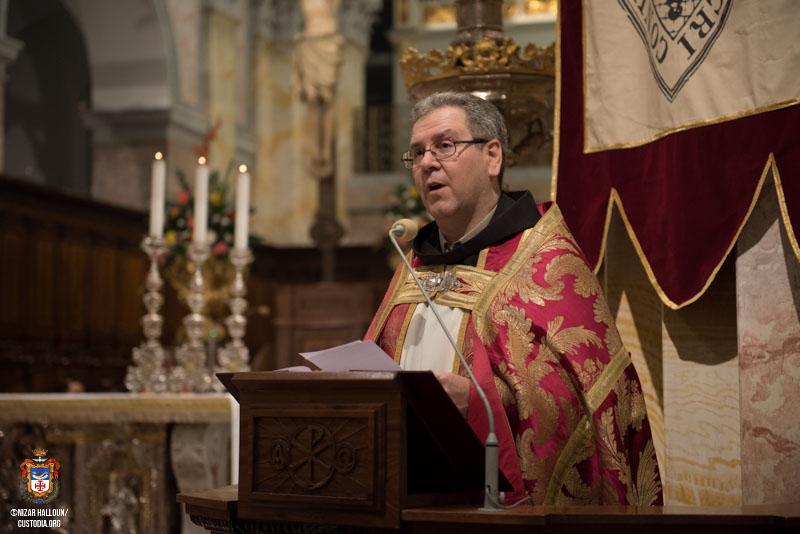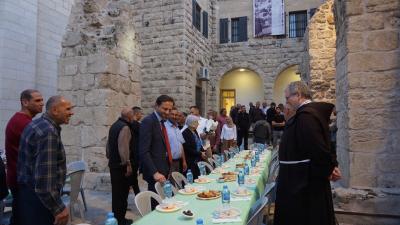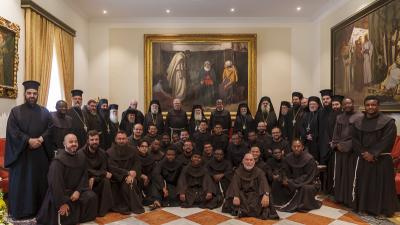
St. Savior’s has returned to normal after the excitement of the last few days. The celebrations of the 800-year presence of the Franciscans in the Holy Land have left a positive impression on all those who participated. Even the Custos of the Holy Land, Fr. Francesco Patton, was very pleased with how the celebrations went. He wished to retrace the highlights from the past week.
How were these days of celebration in Jerusalem?
They were extraordinary days due to their intensity, quality, as well as from an emotional point of view for us friars of the Holy Land. Specifically, the Holy Father’s letter was a welcome surprise, and we felt it to be somewhat of a Gratis Agimus, which he quoted and validated. For us friars of the Custody, it is extremely important to know that we are validated and supported by the universal Church. This letter encouraged us and motivated us to keep going.
Cardinal Sandri’s lecture was very powerful. Also, in his intentions, he paraphrased Chapter XVI of the Rule of St. Francis, the text we refer to for the meaning and the way we carry out our mission in the Holy Land. Cardinal Sandri gave us a lot of encouragement. He emphasized the international dimension of the Custody and the importance that it always be like Pentecost, never like Babel. He recalled that this international aspect is a very strong value here where the Church was born and where difficulty lies in welcoming, understanding and listening to different peoples, cultures and languages.
This is how he also highlighted the cultural value of the Custody, which is extremely significant to me at a time when we are also making an effort to build the Terra Santa Museum. We recently showed the Cardinal the multimedia section of the museum and also some of the rooms that are being completed for the archaeological section at the Monastery of the Flagellation. I saw that he demonstrated interested, because Cardinal very well understands the value that the cultural aspect of the work carried out by the Custody of the Holy Land has.
As for the General Minister's visit, what was the experience like for you friars?
The meeting with Fr. Michael Perry had a more fraternal character. He encouraged us with his homily during the mass that he celebrated. With him, we had a moment of dialogue and sharing. He also emphasized some important dimensions, such as that of fraternal life. At the core of fraternal life, there is first and foremost a relationship with God. It is becoming aware of our vocation and that our vocation be shared with others in a brotherhood.
Fr. Michael Perry has specially emphasized the missionary consciousness that we must have, and he focused on permanent formation, which is something that is absolutely necessary for us. In fact, through permanent formation, adherence to God’s call avoids becoming stale. Permanent formation allows us to continue asking the basic questions: Why are we here today? What does it mean to be friars minor in the Holy Land? And how can we make this relevant for today? It was a fruitful and fraternal dialogue, and the friars were happy about this meeting with the Minister General. For us, he is the presence of St. Francis today. At the meeting with the Minister General were-experienced what the first friars experienced when they arrived here 800 years ago and when Francis himself came in 1219 to encourage them to promote this mission.
What kind of contribution did the lectures make during the celebrations?
These lectures were high quality from an academic point of view. In the program, we gave preference to the meetings with Fr. Michael Perry and Cardinal Sandri, but we wanted it to be a learning opportunity for the friars of the Custody and for those who wanted to participate. The speakers made a very significant contribution, including those who spoke about Friar Elias, about Acre at the time of the first friars, about the frescoes in the Upper Basilica in Assisi and about the work of our archaeologist friars in Syria. The intention of these talks was to create a complete picture and to link ancient and recent history.
What are the next initiatives planned to continue celebrating the 800 years of Franciscan presence in the Holy Land?
The objective is to continue proposing various kinds of initiatives. 2019-2020 is the eighth centenary of the arrival of St. Francis in the Holy Land.
We can certainly continue the in-depth reports that we are transmitting in various languages through the Custody’s media: the website, the Christian Media Center and Terra Santa Magazine.
I am also thinking about the initiatives that we have been participating in and that we will be doing again, such as the Rimini meeting this summer, where we brought a photographic exhibit about the Custody. I am also thinking about the reproductions of Giotto’s frescoes, which were exhibited here in the Custodial Curia. We brought them here with the intention of bringing them to the Terra Santa Schools. At least one of these frescoes depicts the presence of the Franciscans, specifically St. Francis’ meeting with the Sultan in Damietta.
The final concert for the celebrations was a very well attended event and I think it will therefore be appropriate in the next three years to give more visibility to organizations such as the Magnificat, increasing awareness and thus about them in the area.
Over the course of this three-year period for the 800-year anniversary celebrations, there will also be the opening of the archaeological section of the Terra Santa Museum at the Flagellation, which will have the result of helping locals learn more about this history. The multimedia section is already doing it. During the first months of the year, there were more than 2,000 students in attendance and at least another 2,000 are expected in the coming months. With the opening of the new premises for the archaeological section, we will give new impetus to these projects. Before 2019, I also hope to open some sections of the historical museum and then to complete them little by little.
We should also open a room in the Christian Information Center that allows us to reconstruct the whole history of the Calvary and Holy Sepulcher area and to see how it has evolved through the centuries via multimedia resources.
All of these will be educational opportunities. I trust that the online exhibits will continue, as this is tradition for the Custody’s Library.
I hope that for the 800th anniversary we may enter our schools and our parishes so as to make it clear to the local community that they are part of a history that is also Franciscan history.
Beatrice Guarrera




